Embark on a captivating journey through the exquisite world of Indian miniature paintings, a timeless art form that has enchanted collectors and enthusiasts for centuries. Indian miniature paintings are small, detailed works of art that have played a big role in preserving India’s culture and history.
These Indian miniature paintings, though often no larger than a modern smartphone, have been important for many centuries, beginning around the 9th century CE.
From the opulent Mughal courts to the vibrant Rajasthani kingdoms, Indian miniature paintings showcase a diverse range of styles, techniques, and subjects that continue to inspire artists and art lovers alike.
Miniature paintings started as illustrations for books and manuscripts, but over time, they became a popular way to tell stories, document history, and show artistic talent. These paintings often depict scenes from religious stories, legends, and everyday life, giving us visual ideas of India’s past.
The Importance of Indian miniature Paintings from India culture is immense. They act as a link between the past and present, showing modern viewers what life, customs, and beliefs were like in ancient times. Many of the religious and mythological scenes in these paintings have helped keep old stories alive.
In this article, we’ll explore the fascinating history, unique characteristics, and enduring appeal of these miniature marvels, inviting you to discover the beauty and significance of Indian miniature paintings in today’s global art landscape.
Passing down knowledge and culture from one generation to the next. What makes Indian miniature paintings even more special is their variety. Different regions of India developed their own styles, each with unique features.
For example, Pahari paintings are known for their delicate details, while Rajasthani paintings are famous for their bright, bold colours. Together, these regional styles show the diversity of India’s art and culture.
Creating these paintings required great skill. Artists used tiny brushes, sometimes made from a single squirrel’s hair, to apply bright colours made from minerals, plants, and even precious stones. This delicate work took a lot of time and patience, and the artists were highly respected, often working for royal patrons.
Today, Indian miniature paintings continue to amaze art lovers worldwide. They inspire modern artists and designers and are treasured in museums and private collections. Today we will see the world of Indian miniature paintings, India’s history and culture through their paintings and beautiful Art’s.
The Origins of Indian Miniature Paintings
Ancient Roots (Pre-1000 CE)
- Palm Leaf Traditions
The earliest known miniature Paintings from India were found on palm leaves, in the 9th and 10th centuries CE.

Folio from a Buddhist Manuscript of Pancavimsatisahasrika Prajnaparamita,Pala period, ca. 1090, India ,Opaque watercolor on palm leaf
Geographical Distribution: These early palm leaf manuscripts were primarily found in western India, particularly in the regions of Gujarat and Rajasthan.
Religious Texts: The illustrations in these manuscripts were predominantly found in religious texts, such as Buddhist and Jain scriptures.
Palm leaf manuscripts: can be found in various museums and private collections around the world,
Period: ranges from a few hundred to several thousand years.
- Buddhist Influence
Ajanta Cave Paintings: The Ajanta Cave paintings, in the 2nd century BCE to the 6th century CE, are often considered precursors to Indian miniature painting.
Depictions of Buddhist Tales: These cave paintings represent various Buddhist tales and the life of Buddha, providing early examples of narrative illustration in Indian art.

are famous worldwide for their stunning paintings and sculptures. The mural likely portrays a Buddhist deity or a scene from Buddhist mythology, showing the intricate artistry and religious devotion of the time.
Early Hindu Manuscript Illustrations (1000-1300 CE)
- Jain Manuscripts
Kalpasutra and Kalakacharya-katha: Jain manuscripts, such as the Kalpasutra and Kalakacharya-katha, were among the earliest examples of Hindu manuscript illustrations.
Western Indian Style: These manuscripts developed a distinctive Western Indian style, characterized by their delicate lines and vibrant colours.
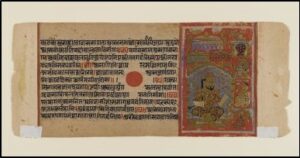
Leaf from a Dispersed Jain Manuscript of the Kalakacharya-katha, ca. 1450–1475. Opaque watercolor and gold on paper, Brooklyn Museum,
- Hindu Texts
Illustrations of Epics: Hindu epics, like the Ramayana and Mahabharata, were also illustrated in early manuscripts.
Emergence of Regional Styles: The illustration of these texts led to the emergence of regional styles, reflecting the diverse cultural and artistic traditions of different parts of India.
- Materials and Techniques
Palm Leaf: Palm leaves were the primary medium used for early miniature paintings.
Pigments: Natural pigments, such as mineral pigments, were used to create the colours.
Brushes and Tools: Fine brushes made from animal hair and other tools were used to apply the pigments to the palm leaf surface.
- Themes and Subjects
Religious Iconography: Indian Miniature paintings often depicted religious iconography, including deities, saints, and mythological scenes.
Cosmological Diagrams: Some manuscripts included cosmological diagrams, illustrating the universe and its various elements.
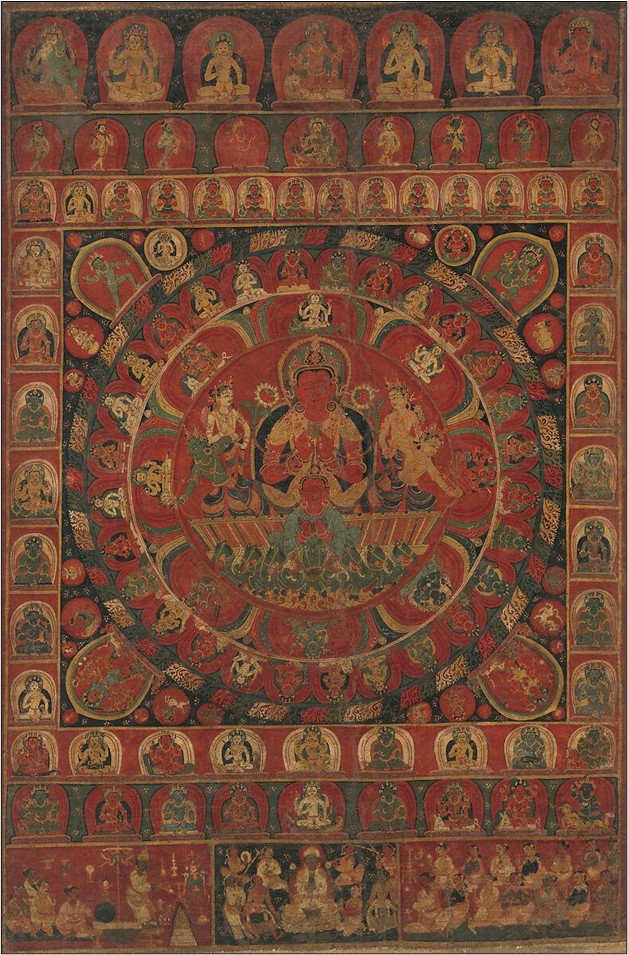
Mandala of the Sun God Surya,The MET Museum
Royal Patronage and Court Scenes: Miniature paintings were also commissioned by royal patrons to depict court scenes, royal processions, and other events.
- Stylistic Elements
Perspective and Composition: Early miniature paintings often employed simple forms of perspective and composition, with a focus on creating a harmonious and balanced visual experience.
Use of Colour and Outlines: Vibrant colours and delicate outlines were characteristic features of early miniature painting.
Symbolism and Hierarchical Scaling: Symbolism and hierarchical scaling were often used to convey meaning and importance within the composition.
Regional Variations
Eastern India (Pala Dynasty): The Pala Dynasty in eastern India produced distinctive miniature paintings, characterized by their intricate details and use of gold leaf.
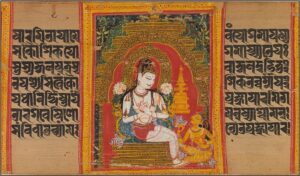
Bodhisattva Avalokitesvara Expounding the Dharma to a Devotee: Artist: Mahavihara Master Period: Pala period, early 12th century,The Met Museum.
Western India (Gujarat and Rajasthan): Western Indian miniature paintings, particularly from Gujarat and Rajasthan, developed a unique style with a focus on narrative and storytelling.
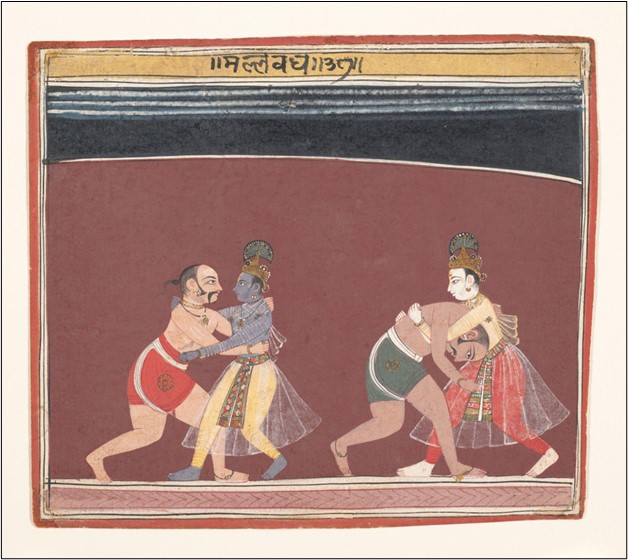
Krishna and Balarama Fight the Evil King Kamsa’s Wrestlers: Page from a Dispersed Bhagavata Purana, 1650, India (Madhya Pradesh, Malwa), Ink and opaque watercolor on paper,The MET Museum.
Southern India: Southern Indian miniature paintings often incorporated elements of Chola and Vijayanagara art, resulting in a distinctive regional style.
Transition to Paper (13th-14th centuries)
Introduction of Paper: In the 13th and 14th centuries, paper began to be introduced to India, providing a new and more versatile medium for miniature painting.
- Significance in Hindu Culture
Devotional Function: Miniature paintings served a devotional function, helping to connect devotees with the divine.
Preservation of Sacred Texts: Manuscripts with miniature illustrations were used to preserve and transmit sacred texts.
Educational Role: Miniature paintings also played an educational role, illustrating stories and teachings from religious texts.
- Notable Examples
Early manuscripts and illustrations: Some notable examples of early miniature paintings include the Kalpasutra manuscript from the 12th century and the illustrations in the Bhagavata Purana manuscript from the 13th century.
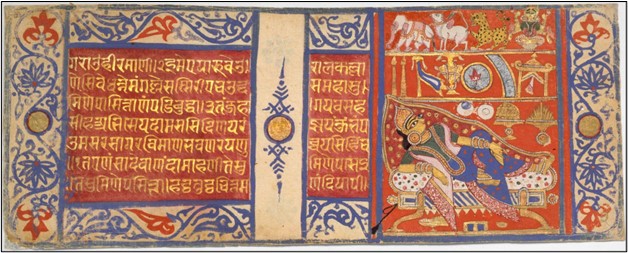
Devananda’s Fourteen Auspicious Dreams Foretelling the Birth of Mahavira: Folio from a Kalpasutra Manuscript,Jaunpur Kalpasutra (Indian), ca. 1465, India, (Gujarat, Jaunpur), Opaque watercolor on paper,The MET Museum.
- Legacy and Influence
Impact on later miniature painting traditions: The early miniature paintings laid the foundation for the development of later miniature Paintings from India, such as the Mughal, Rajput, and Pahari schools.
Persian Influence and the Development of Major Schools
Persian Techniques and Styles in Indian Painting
When the Mughals came to India in the 16th century, they brought with them Persian art traditions. These included techniques like using natural colors, fine brushwork, and detailed patterns. These Persian styles mixed with the existing Indian ways of painting, leading to a unique blend of both cultures.
Mughal School of Painting
History: The Mughal School became popular with the support of Mughal emperors like Akbar, Jahangir, and Shah Jahan.

Shah Jahan on a Terrace, Holding a Pendant Set With His Portrait”, Folio from the Shah Jahan Album
Artist: Painted by Chitarman (Indian, active ca. 1627–70)
The MET Museum
Style: Mughal paintings are known for their lifelike details, use of perspective, and realistic scenes. They often show court life, hunting trips, and religious events.
Famous Artists and Works: Famous painters of this style include Ustad Mansur, Abdul Hasan, and Bihzad. Some well-known works are the “Khamsa of Nizami,” “Tutinama,” and “Padshahnama.”
- Rajasthani School of Painting
Regional Styles: The Rajasthani School has several sub-styles based on regions like Mewar, Bundi, Jaipur, and Kota.
Themes: These paintings often depict stories from Hindu mythology, religious events, and royal life. They are known for their bright colors, detailed designs, and strong storytelling.
Famous Artists and Works: Key painters include Nainsukh, Sahibdin, and Nihal Chand. Notable works include the “Ragmala” series and “Rasikapriya.”
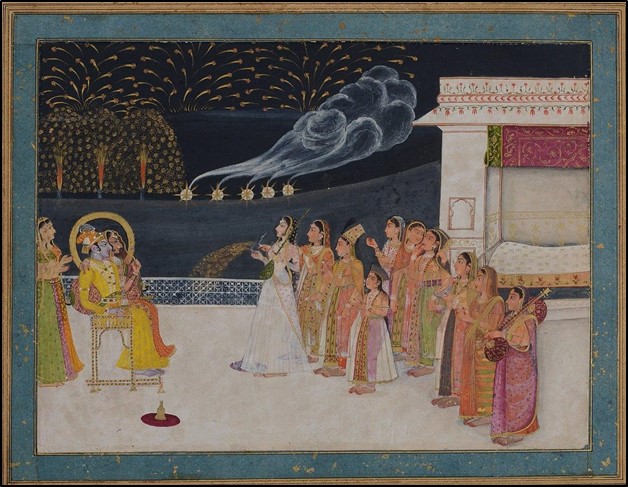
KishanGarh style painting -Radha and Krishna watching fireworks in the night sky by Sitaram. Kishangarh, late 18th-century. National Museum, New Delhi
- Pahari School of Painting
Location: The Pahari School developed in the hilly regions of Jammu and Kashmir, Himachal Pradesh, and Uttarakhand.
Style: Pahari paintings focus on emotions, using soft colors and a flowing, lyrical style. They often show scenes from Hindu mythology and poetry.
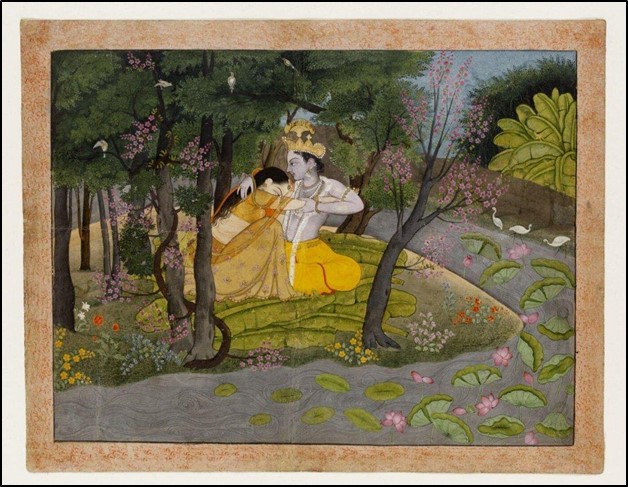
Famous Artists and Works: Some well-known artists are Nund Lal, and the Guler and Basohli schools are famous for their styles. Important works include the “Bhagavata Purana” and “Ragamala” series.
- Deccan School of Painting
History: The Deccan School developed in southern India, supported by the Deccan Sultanates.
Style: Deccan paintings are a mix of Persian, Mughal, and local Indian styles. They often show Islamic and Hindu stories, as well as royal court life.

Famous Artists and Works: Notable artists include Mir Sayyid Ali, Abd al-Samad, and Ibrahim Adil Shah II. Famous works include the “Khamsa of Nizami” and “Tarikh-I Firishta.”
Techniques and Materials in Indian Miniature Paintings
- Pigments and Colors
Natural Pigments: Indian miniature painters primarily used natural pigments derived from minerals, plants, and animals. These included lapis lazuli (blue), vermilion (red), malachite (green), and gold leaf.
Colour Theory: Indian artists developed a sophisticated understanding of colour theory, using color to create mood, symbolism, and hierarchy within their compositions.
- Brushes and Other Tools
Fine Brushes: Artists used fine brushes made from animal hair, such as camel hair or squirrel hair, to create delicate details and intricate patterns.
Other Tools: Additional tools included pens, knives, and burnishers for applying gold leaf and creating textures.
- Canvas Preparation
Paper and Cloth: Early miniature paintings were often created on palm leaves, but later artists adopted paper and cloth as their primary supports.
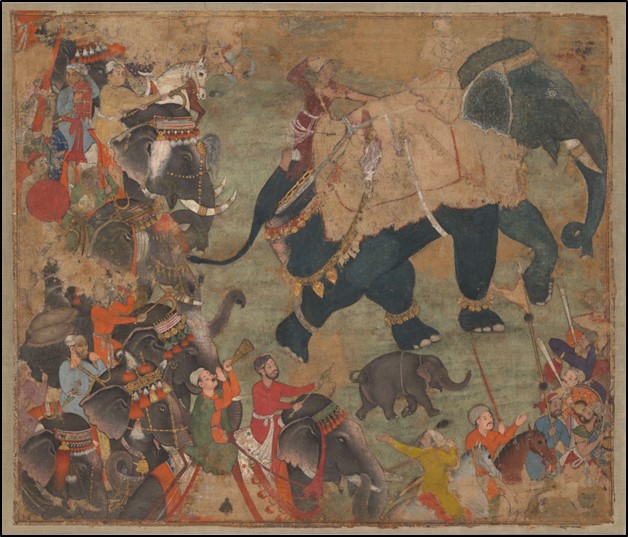
A Prince Riding an Elephant in Procession,1570 Met Museum
Preparation: The paper or cloth was prepared by sizing it with a mixture of animal glue and alum to create a smooth surface for painting.
- Evolution of Techniques Over Time
Persian Influence: The arrival of the Mughals introduced new techniques and materials from Persia, such as the use of perspective and shading.
Regional Variations: Different regions of India developed their own unique techniques and styles, reflecting the diverse cultural and artistic traditions of the subcontinent.
Innovation: Indian artists continued to innovate throughout the centuries, experimenting with new materials, techniques, and subjects.
Themes and Subjects in Indian Miniature Paintings
- Religious and Mythological Scenes
Hindu Deities: Miniature paintings often depicted Hindu deities, such as Vishnu, Shiva, Krishna, and Rama.
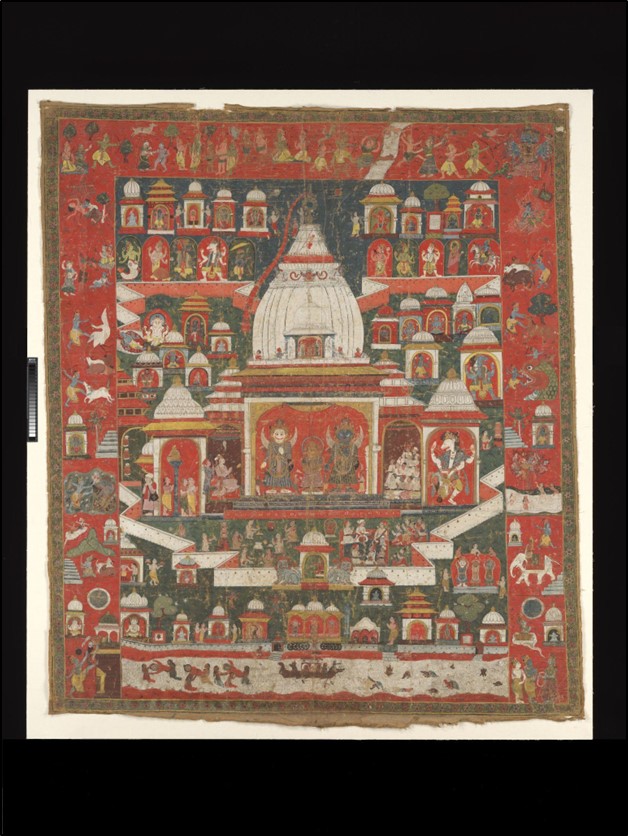
Celebrating Krishna as Lord of the Universe (Jagannatha) at his temple in Puri, in Odisha (Orissa), eastern India, 18th century,Opaque pigments on cotton , MET Museum.
Mythological Narratives: The epics of the Mahabharata and Ramayana were frequently illustrated, providing rich source material for narrative paintings.
Religious Festivals: Festivals such as Holi, Diwali, and Krishna Janmashtami were also popular subjects.
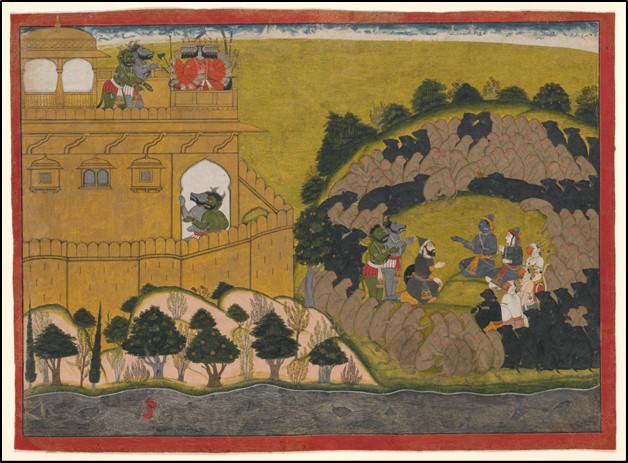
Rama Releases the Demon Spies Shuka and Sarana: Folio from the Siege of Lanka series (Ramayan) Ca 1725, The Met Museum
- Court Life and Historical Events
Royal Portraits: Portraits of kings, queens, and other members of the royal court were common themes.
Court Scenes: Scenes of court life, such as royal audiences, hunting expeditions, and celebrations, were often depicted.
Historical Events: Important historical events, such as battles, conquests, and diplomatic missions, were also illustrated.
- Nature and Wildlife
Landscapes, including mountains, forests, rivers, and gardens, were often depicted in miniature paintings. Animals such as elephants, tigers, deer, and birds were frequently featured in natural scenes. Paintings often depicted seasonal themes, such as the monsoon, spring, and autumn.
- Portraiture and Daily Life
Individual Portraits: Portraits of individuals, both royal and non-royal, were common.
Daily Life: Scenes of daily life, such as people working, playing, and socializing, were also depicted.
Urban and Rural Scenes: Miniature paintings often depicted both urban and rural settings, providing view of diverse lifestyles of India.
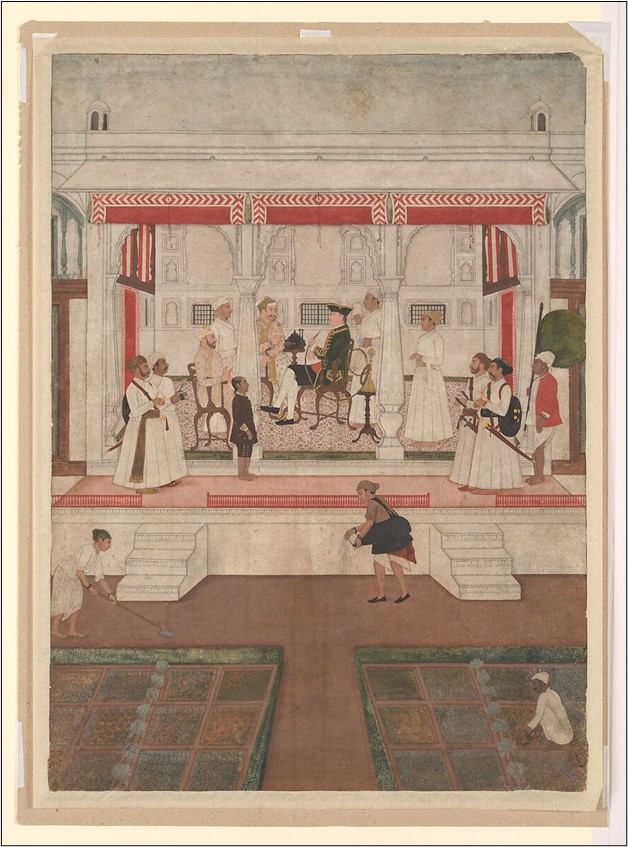
Company Officer Receiving a Nobleman ca. 1760–65, The Met Museum
Famous Indian Miniature Paintings and Artists
- Highlight Renowned Works
Khamsa of Nizami: A Persian epic poem illustrated by artists from the Mughal School, renowned for its exquisite detail and vibrant colors.
Tutinama: A Persian collection of tales illustrated by Mughal artists, known for its imaginative storytelling and intricate designs.
Padshahnama: A Mughal chronicle of Shah Jahan’s reign, featuring lavish illustrations of court life, historical events, and natural scenes.
Ragmala: A series of paintings depicting the various ragas (musical modes) of Indian classical music, often found in Rajasthani and Pahari schools.
Bhagavata Purana: A Hindu religious text illustrated by artists from the Pahari School, renowned for its lyrical style and emotional intensity.
- Notable Artists and Their Contributions
Ustad Mansur (Mughal School): Known for his realistic depictions of animals, particularly birds.
Abul Hasan (Mughal School): Renowned for his portraits and historical scenes, characterized by their meticulous detail and refined style.
Nainsukh (Rajasthani School): A master of portraiture, known for his ability to capture the individuality and character of his subjects.
Sahibdin (Rajasthani School): Renowned for his narrative paintings, particularly those depicting scenes from the Ramayana and Mahabharata.
Nund Lal (Pahari School): A pioneer of the Pahari style, known for his lyrical and emotional approach to painting.
- Analysis of Masterpieces
Khamsa of Nizami: The Khamsa of Nizami showcases the Mughal School’s mastery of perspective, colour, and narrative. The illustrations are characterized by their realism, intricate detail, and vibrant palette.
Ragmala Series: The Ragmala series, found in Rajasthani and Pahari schools, demonstrates the artists’ ability to convey emotion and meaning through colour, composition, and symbolism. The paintings often feature lyrical landscapes, expressive figures, and symbolic imagery.
Bhagavata Purana: The Bhagavata Purana illustrations from the Pahari School highlight the lyrical and emotional qualities of the style. The paintings are characterized by their soft colors, expressive lines, and emphasis on the spiritual and mystical aspects of the text.
The Evolution of Indian Miniature Paintings
Changes in style from early Hindu period to later schools
Indian miniature painting has undergone significant transformations over the centuries. The early Hindu period, dating back to around the 8th century, was characterized by religious themes, predominantly featuring Hindu deities and epics. These early works used bold, vibrant colors and stylized figures, often lacking perspective but rich in symbolic meaning.
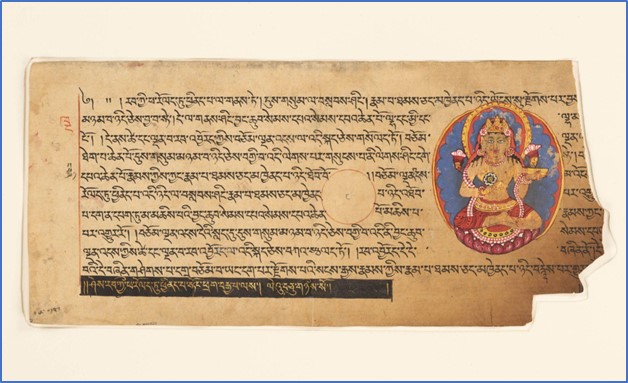
Fragment of a Prajnaparamita Sutra manuscript folio,ca. 11th century, Ancient Kingdom of Kashmir, India,colors and black ink on paper,The MET Museum.
As time progressed, various schools of miniature painting emerged. The Mughal era (16th-19th centuries) brought a dramatic shift in style. Influenced by Persian art, Mughal miniatures introduced more realistic portrayals, especially in portraiture. They also expanded subject matter to include court scenes, historical events, and nature studies. The use of fine brushwork and delicate detailing became hallmarks of this period.
The Rajput schools, which developed in the princely states of Rajasthan and central India, combined elements of Mughal style with indigenous traditions. These paintings are known for their vibrant colors, romantic themes, and depiction of local legends. Each regional court developed its distinct style, such as the bold Bundi school or the delicate Kishangarh school.
The Pahari schools, centered in the Himalayan foothills, emerged in the 17th century. They are noted for their lyrical quality, with delicate lines and cooler colour palettes. These schools often focused on Krishna legends and other Hindu mythological themes, creating dreamlike, idealized landscapes.
Influence on modern Indian art
miniature painting has significantly impacted modern Indian art. Many 20th-century Indian artists, seeking to create a distinctly Indian modernism, drew inspiration from miniature traditions. This led to neo-traditional movements that blended miniature techniques with contemporary themes and styles.
Modern artists have incorporated elements of miniature Paintings from India, such as its intricate detailing and narrative approach, into larger canvases and new mediums. Some have revived the use of traditional pigments and materials, seeking to preserve and evolve these ancient techniques.
The miniature tradition has also influenced modern Indian graphic design, book illustration, and even some forms of digital art, demonstrating its enduring relevance in visual culture.
Contemporary interpretations of miniature painting traditions
In recent decades, there’s been a resurgence of interest in miniature painting, with artists finding innovative ways to reinterpret this tradition. Some contemporary artists create fusion works that combine miniature techniques with modern art styles like abstraction or surrealism.
Digital technology has opened new avenues for miniature-inspired art. Artists use digital tools to create works that mimic the intricacy of traditional miniatures or to distribute their art to wider audiences.
Many contemporary artists use the aesthetic language of miniatures to address current social and political issues. They might employ traditional compositions and techniques to depict modern scenes or to critique contemporary society, creating a striking juxtaposition of old and new.
Some artists have expanded the scale of miniature painting, creating large works that invite viewers to engage with the minute details traditionally associated with the form. Others experiment with unconventional materials while maintaining the spirit of miniature painting.
This evolution showcases how Indian miniature painting, rooted in centuries-old traditions, continues to adapt and remain relevant in the contemporary art world, bridging the gap between India’s rich artistic heritage and its dynamic present.
Collecting and Preserving Indian Miniature Paintings
Tips for collectors
Firstly Verify authenticity and provenance, Assess condition carefully before purchasing then Use acid-free matting and UV-protective glass for framing and Build relationships with reputable dealers and experts.
Conservation challenges and techniques
Maintain stable temperature (around 70°F/21°C) and humidity (45-55%), Limit light exposure, especially UV rays, Handle with clean, dry hands or cotton gloves and Store flat in acid-free materials also Consult professional conservators for significant repairs
Ethical considerations
Ensure legal acquisition and export, Recognize cultural significance to communities of origin, Be open to repatriation discussions if warranted
Then Prioritize long-term preservation and Allow access for research and education, when possible, also Comply with international laws on cultural property trade.
Indian Miniature Paintings in Global Art Markets
Value and demand for these paintings
- High demand among collectors, museums, and art enthusiasts
- Prices vary widely based on age, condition, artist, and historical significance
- Rare Mughal and early Rajput paintings command premium prices
- Growing interest in lesser-known schools, driving up their value
- Contemporary miniatures gaining traction, offering more affordable options
Notable auctions and sales
- 2011: A Mughal miniature sold for $2.3 million at Christie’s
- 2017: “The Trumpeters” by Nainsukh of Guler fetched £2.4 million at Sotheby’s
- 2019: A Pahari painting from 1780 sold for $2.6 million at Sotheby’s
- Bonhams and Christie’s regularly feature Indian miniatures in their Asian art sales
- Private sales through galleries often achieve significant but undisclosed prices
Trends in collecting and appreciation
- Increased interest from international collectors, not just Indian diaspora
- Growing appreciation for regional styles beyond Mughal and Rajput schools
- Rising demand for well-documented provenance due to authenticity concerns
- Collectors focusing on specific periods or themes for specialized collections
- Museums actively acquiring to fill gaps in their South Asian art collections
- Digital platforms enabling broader access and education about miniature art
- Emergence of young collectors drawn to the intricate details and cultural narratives
- Crossover appeal to contemporary art collectors seeking diverse portfolios
- Renewed academic interest driving scholarly publications and exhibitions.
Experiencing Indian Miniature Paintings in the USA
Major Museums and Galleries
- The Metropolitan Museum of Art, New York City: Known for its vast collection of art from around the world, the Met has a notable collection of Indian miniatures, including works from various regional styles.
- The National Gallery of Art, Washington, D.C.: This prestigious gallery features a diverse collection of art, including Indian miniatures, showcasing the artistic traditions of the subcontinent.
- The Freer Gallery of Art and the Arthur M. Sackler Gallery, Washington, D.C.: These sister museums specialize in Asian art, including Indian miniatures, and offer in-depth exhibitions and programs.
- The Museum of Fine Arts, Boston: This museum has a collection of Indian art, including miniatures, that spans various periods and styles.
- The Los Angeles County Museum of Art (LACMA): LACMA’s collection includes Indian miniatures, providing a glimpse into the artistic heritage of the region.
Exhibitions and Events
Keep an eye out for temporary exhibitions dedicated to Indian miniature paintings. These events often show specific themes, periods, or artists, providing a more focused experience.
Check museum websites and newsletters Many museums announce upcoming exhibitions and events related to Indian art, including miniatures. Follow art-related social media Platforms like Instagram and Facebook often feature updates about exhibitions and events at museums and galleries.
Virtual Experiences and Digital Collections
Many museums offer virtual tours and online catalogues that allow you to view their collections of Indian miniatures. Then Digital art libraries, Websites like Artnet and MutualArt often feature digitized Indian miniature paintings. Also, Online exhibitions, Some museums and galleries curate online exhibitions of Indian miniatures, providing a convenient way to explore these artworks.
The Cultural Impact of Indian Miniature Paintings
Influence on Literature and Poetry
Miniature Paintings from India often depicted scenes from epics like the Ramayana and Mahabharata, enriching the visual understanding of these literary works.
The beauty and symbolism in miniature paintings inspired poets to write verses that complemented and enhanced the visual narratives.
Role in Cultural Diplomacy
Indian rulers often gifted miniature paintings to foreign dignitaries, fostering cultural exchange and diplomatic relations. Miniature paintings served as a means to preserve and represent India’s rich cultural heritage to the world.
Inspiration for Contemporary Artists
Contemporary artists often draw inspiration from traditional miniature painting techniques, incorporating them into their miniature paintings has led to a resurgence of interest in this art form, encouraging new generations of artists to explore its possibilities.
Conclusion
As we conclude our journey through the captivating world of Indian miniature Paintings from India, it’s clear why these exquisite artworks continue to enchant global audiences. From their origins on palm leaves to the opulent Mughal courts and vibrant regional styles, these tiny masterpieces offer Western collectors and art enthusiasts a unique window into India’s rich cultural tapestry. Their intricate details, vibrant colors, and diverse themes showcase centuries of artistic innovation and storytelling.
The enduring appeal of Indian miniature paintings extends far beyond their aesthetic beauty. These works serve as visual chronicles of history, religion, and daily life in India, influencing literature, poetry, and even contemporary design. As interest in Indian art grows worldwide, museums, galleries, and digital platforms across the United States and Europe are making these treasures more accessible than ever, allowing a new generation to discover their magic.
Looking ahead, the future of Indian miniature paintings is bright. With increasing opportunities for research, conservation, and artistic reinterpretation, these timeless treasures continue to inspire and captivate. Whether you’re a seasoned collector or a curious newcomer, exploring the world of Indian miniature paintings promises a rewarding adventure in art, history, and culture. These small wonders invite us all to take a closer look at the big impact of India’s artistic heritage on the global stage.

